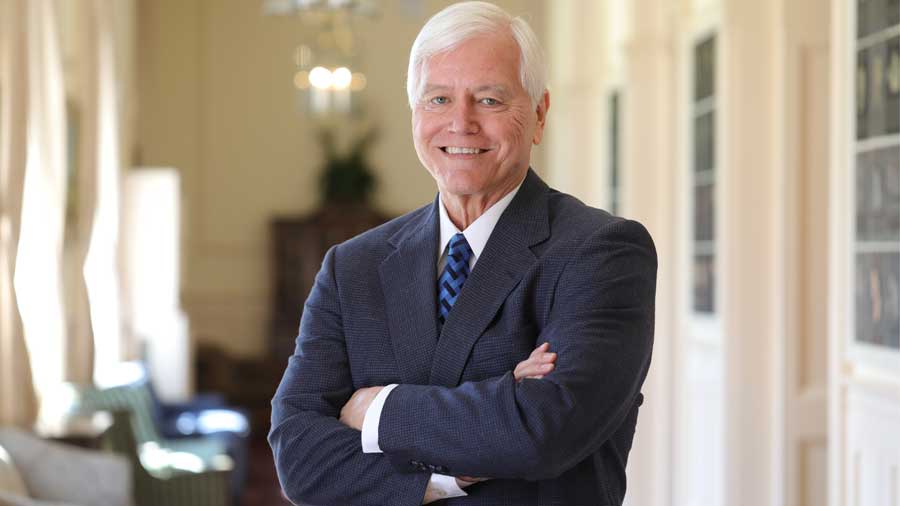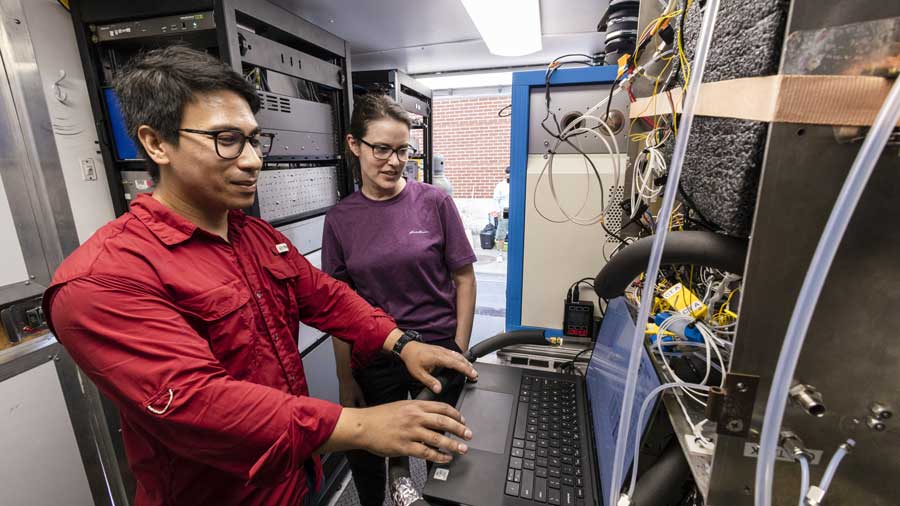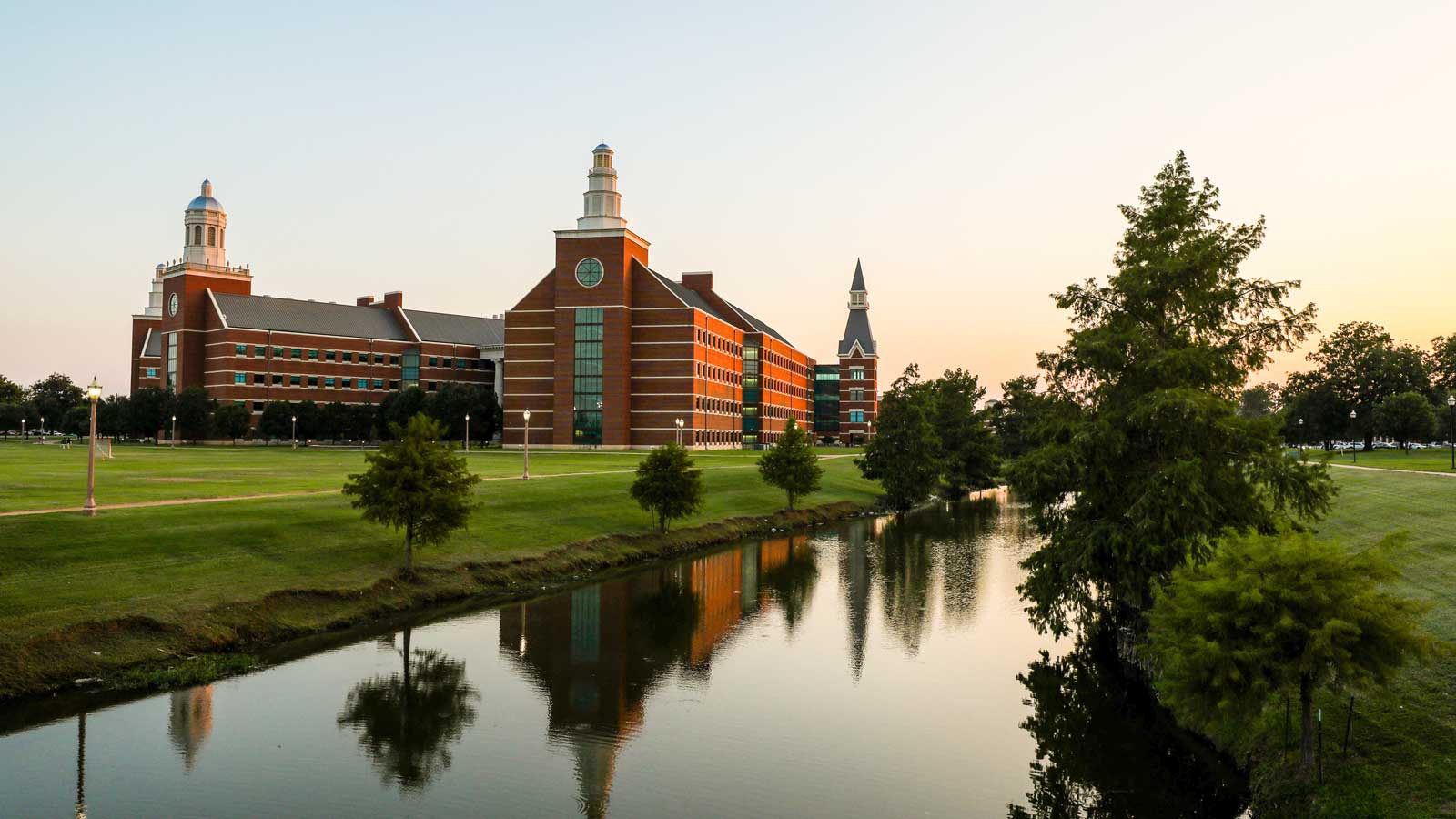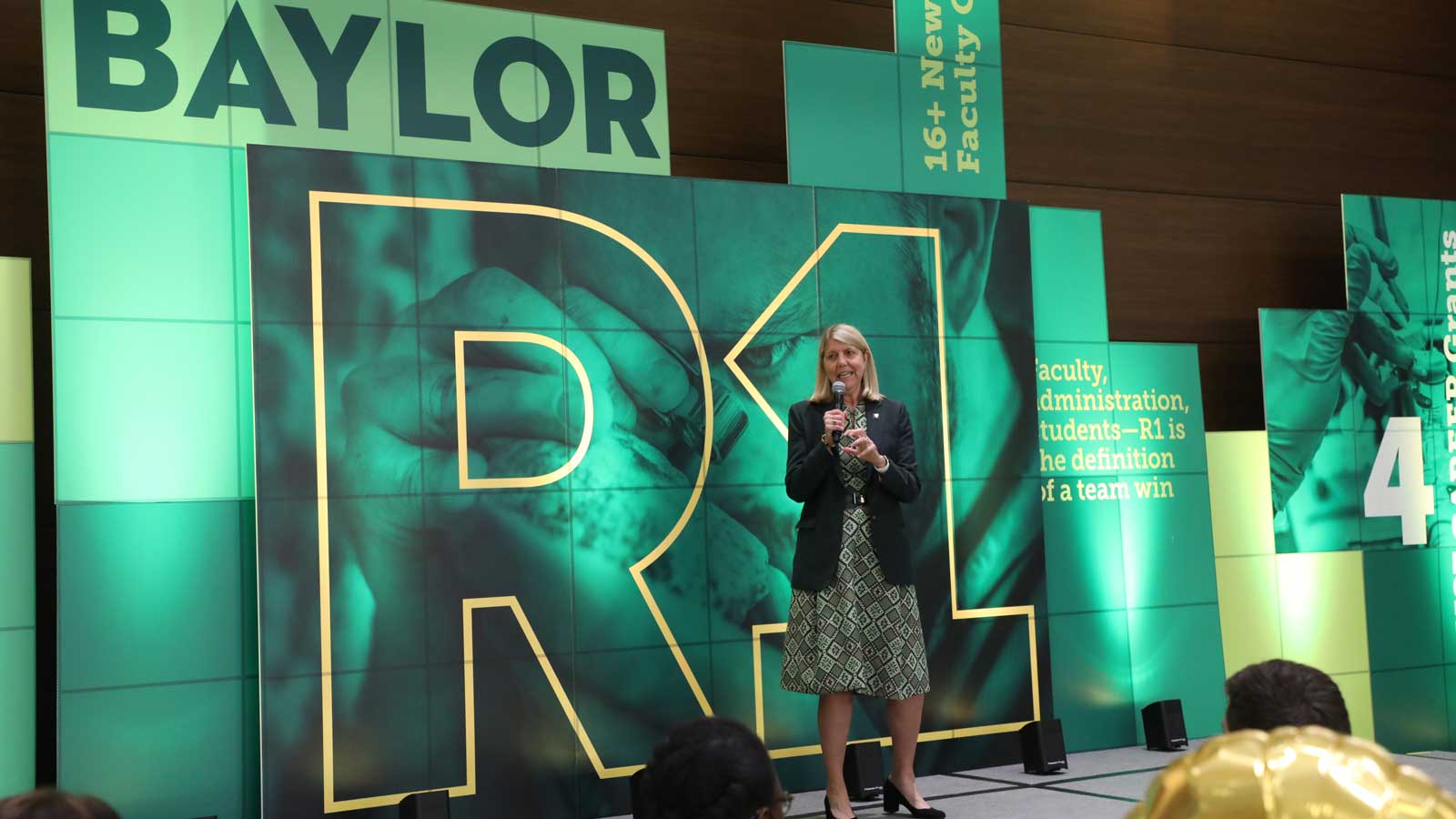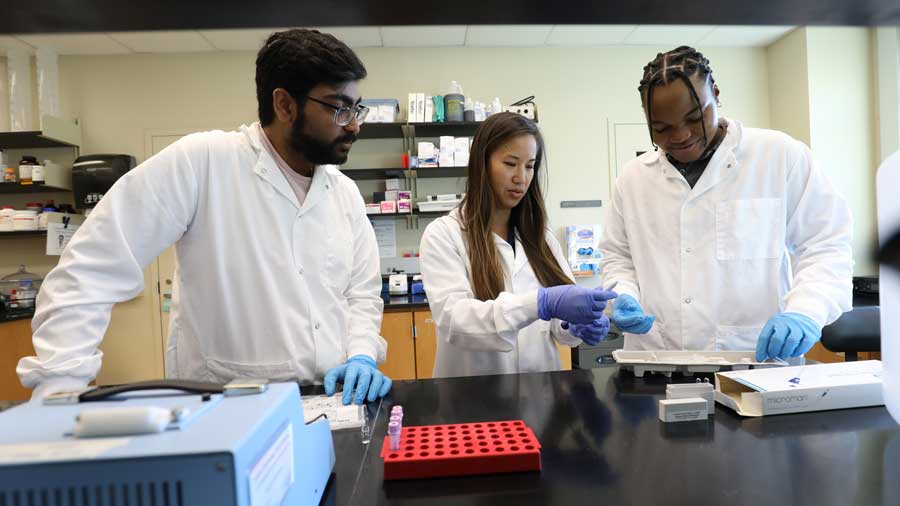Baylor1
Built on the strong foundation of generations of scholars and a bold vision for the future, Baylor's R1 designation marks an important moment on a longer journey.
From the very beginning, the dream of Baylor University as an internationally recognized, preeminent Christian research university was audacious. While it’s commonplace to hear dreams of expansion or elevation, the multi-generational work and unified focus required to reach them leaves many of those goals unfulfilled. And further, few could contemplate the idea of setting these goals as a Christian research university. Across higher education, there were very few models to follow. Many universities founded on a faith foundation simply left it behind on the road to transformative growth and elite research status.
Audacity was required to even think of Baylor as a research institution a generation ago. Within the lifetimes of many alumni, Baylor was primarily an undergraduate university. It was an outstanding undergraduate and teaching university, and highly regarded as such, but still far from the type of place whose peer institutions would be the most prestigious in the nation.
“A shared goal was for Baylor to be influential in creating a space where Christian perspectives would have an impact.”LARRY LYON, B.S. ’75, PH.D., VICE PROVOST AND DEAN OF THE GRADUATE SCHOOL
Fortunately for Baylor, a sense of mission-centered boldness has never been in short supply. Going back to 1845, Baylor’s founders saw the need for a Christian university “fully susceptible of enlargement and development to meet the needs of all the ages to come.” It was a vision large enough to spur pursuits previous generations might never have imagined, and a charge compelling enough to encourage the work that led Baylor to be recognized as a Research 1 university by the Carnegie Classification of Institutions of Higher Education — the best of the best — in 2021, three decades after the first seeds were planted.
It wasn’t that the end goal for Baylor was R1 recognition. The driving force was that, as President Linda A. Livingstone, Ph.D., said in her 2017 inaugural address, “the world needs a Baylor that is committed to finishing the race we have started.”
1990-2005
Baylor 2012 Takes Shape
Even the leaders at the center of the changes that would come in the 1990s had little idea what was in store when the decade began. By 2000, Baylor’s athletic teams would be part of a newly formed Big 12 Conference, surrounded by new peer institutions after decades in the regional Southwest Conference. Academically, conversations were taking place that would eventually galvanize Baylor’s transition to a national university as well.
“Baylor had seen itself, quite appropriately, as a regional, Baptist, teaching university, and we were very good at that,” Larry Lyon, B.S. ’75, Ph.D., vice provost and dean of the Graduate School, said. “As far as graduate education, there was no understanding of what it would mean to be a research institution, and little motivation to get there, but there were people who thought that was important.”
Among those people were Robert Sloan, B.A. ’70, Ph.D., Baylor President from 1995 to 2005, and then-Provost Donald Schmeltekopf, B.A. ’62, Ph.D., who served from 1990 to 2002.
“We didn’t begin by thinking about Carnegie rankings or R1,” Schmeltekopf said. “But we were thinking about the opportunity to advance the University’s impact beyond teaching and to begin thinking of ourselves more seriously as a Christian research university.”
Schmeltekopf recalls alignment within the President’s Office and in areas around campus, and those informal conversations would, over the years, become committees and recommendations. To combine research growth while doubling down on the University’s Christian commitment would require a shared vision. That was introduced in 2001 when the Board of Regents adopted Baylor 2012 as the University’s strategic vision. Change rarely comes easily, and the Baylor 2012 vision garnered passion both for and against.
“On both sides of the issue, everyone loved Baylor,” Lyon said. “Whether you were for the 2012 vision or against it, these people all loved Baylor, even when their views of what Baylor ought to mean were different.”
A significant motivating factor to answer why Baylor chose the more challenging path lies in influence — or lack thereof. Within the marketplace of influence across higher education and at the tables where significant decisions are made, there were few Christian voices.
“A shared goal was for Baylor to be influential in creating a space where Christian perspectives would have an impact,” Lyon said. “Where major decisions were made, we wanted people trained at the highest levels to reflect a Christian viewpoint. We wanted our graduates to have positions of influence and authority.”
Only Baylor was positioned, among protestant universities, to even consider this path.
Baylor 2012 coalesced various strands of research and scholarly growth, from an increased focus on research to elevating the importance of graduate education. Foundational assumptions within the plan doubled down on the University’s faith commitment. Baylor 2012’s guiding convictions called to “facilitate the discovery of new knowledge,” to “illuminate and enrich human experience by the word of God and the best of human science and culture” and to “encourage the integration of Christian faith and the intellectual life.”
The vision was blessed by the Board of Regents, but not without some trepidation. The path would necessitate significant growth in expenses and funding. Some wondered if the University’s faith commitment would suffer in the pursuit. After all, other universities who pursued this path saw that outcome.
“There was skepticism, and people thought you couldn’t have both a strong faith and excellent academics,” Duane Brooks, B.A. ’84, Ph.D. ’91, a former Baylor Regent and senior pastor of Tallowood Baptist Church in Houston, said. “But I remember we were in a Regent meeting, and it hit me. I told this to Robert Sloan, ‘If the purpose of a ship captain was to keep the ship safe, then he would never take it out of port. It’s safer to stay where you are. But we all know that’s not what ships were made to do — they were made to sail and venture out.’”
As Baylor ventured out, an early sign of the new direction took shape on the edge of campus. The Baylor Sciences Building (BSB) was planned and built, opening in 2004. The largest building project at that point in University history, the BSB was a $103 million, 508,000-square-foot game changer, facilitating collaborative research in the sciences and providing a facility that would attract top students and faculty — and a sign that Baylor was committed to the course it had charted.
Even after Sloan’s tenure as president came to an end in 2005, the Baylor 2012 vision remained intact. Committed scholars continued building on the foundation of the 1990s and early 2000s to position the University for greater research impact.
2005-2017
Faithful Growth and Pro Futuris
In time, the conversations around Baylor 2012 would develop into a new vision to continue progress, and University administrators and academic leaders faithfully took steps to integrate its goals into daily practice.
The result was a growing influx of new faculty, highly regarded as skilled researchers or up-and-coming young talent, all of whom were attracted by the vision of a place that celebrated their Christian faith while pursuing the highest levels of scholarship.
During this time, resources like the Institute for Faith and Learning became a part of the campus community, and new graduate programs were methodically added to the list of offerings. Growth begat growth, and new faculty hires began bearing fruit in research and scholarship. Faculty competed for more significant national grants, and earned them. Baylor, in turn, kept growing the resources available to faculty. Enrollment also increased. In 2007, two core research centers were built in the Baylor Sciences Building, and two more would follow in subsequent years. In 2010, Baylor began construction on the Baylor Research and Innovation Collaborative (BRIC) after the old General Tire facility was donated to the University. By 2013, the first lab had opened in the 330,000-square-foot facility, which now houses dozens of high-tech labs, research spaces and collaborations with industry leaders.
In 2012, celebrating the arrival of the year that had long been a visionary destination, Baylor adopted a new vision, Pro Futuris, with measurable five-year goals that included continued research and academic program growth and a sustained commitment to Baylor’s Christian mission.
Without fanfare, the culture was slowly changing. Bryan Brooks, Ph.D., Distinguished Professor of Environmental Science, came to Baylor in 2002 and recalls the commitment — not only to research growth, but to non-negotiable areas like undergrad mentorship.
“To get where we are, you’ve got to hire well and mentor well,” Brooks said. “So, what does that mean in practice? We found people supportive of the University mission and interested in contributing to research and to engaging with our undergraduate enterprises. That’s all a big part of it. Because, while our research culture changed, it never changed in the way we engage undergraduates. And what was happening was, even as research grew and graduate programs grew, we were creating more opportunities for our undergrads.”
Over the next 12-year period, committed leaders across campus diligently kept Baylor on the path of research growth.
2017-Present
Illuminate to R1
“The world needs a Baylor.”
In 2017, President Livingstone’s inaugural address marked a transition in Baylor’s research growth — from a vision to a distinct goal.
The Baylor that President Livingstone returned to 15 years after her time as a Hankamer School of Business faculty member and leader had transitioned into a burgeoning R2 university — recognized by the Carnegie Classification of Institutions of Higher Education as having “high research activity.” In her address, she called for Baylor to address the world’s greatest challenges at the highest levels — and a vehicle to get there was the pursuit of Carnegie’s highest ranking, Research 1.
“Baylor’s Christian commitment equips us to address challenges in significant and meaningful ways. We have said that our goal is to achieve preeminent research status, what we in academics call Tier 1 status. This goes beyond achieving what the Carnegie Foundation defines as ‘highest research activity,’ or R1 status,” Livingstone said.
“Ultimately, our vision affirms, ‘the world needs a preeminent research university that is unambiguously Christian — where such a commitment does not imply a lack of scholarly inquiry but rather requires scholarship and creative endeavors at the highest levels of quality to complement and inform its teaching and service.’”
For many who had long pursued research growth, it was the first time they had heard someone specifically say “R1,” and that Baylor could get there.
“It was really through the vision of Dr. Livingstone, in my experience, that brought the idea of achieving R1 onto the radar in a strong way,” Jerry Clements, J.D. ’81, former chair of the Board of Regents, said. “We had talked about it, but it was never a focus. And we wondered, when we looked at the five-year plan, ‘can we really do this in five years?’ And, of course, we did it earlier than we envisioned.”
“Baylor’s Christian commitment equips us to address challenges in significant and meaningful ways.”LINDA A. LIVINGSTONE, PH.D.
Within the first year of President Livingstone’s tenure, the Illuminate strategic plan became the University’s roadmap to R1, even though it, like the strategic visions that preceded it, never specifically mentioned R1. With Illuminate, the spark that had led to deliberate and incremental growth, grew like wildfire. In 2019, Baylor officially announced plans to pursue R1 recognition. A University filled with faculty members aligned in pursuit of that goal — both those who had laid the strong foundation upon which the vision was built and those who had been recruited to the vision of a top-tier Christian research University — were ready for the moment.
Kevin Chambliss, Ph.D., joined the Baylor Chemistry and Biochemistry Department in 2001, was appointed as vice provost for research in 2019 and saw that a culture change spanning nearly two decades was maturing.
“Unlike anytime I’d been at Baylor, everyone was aligned and rowed the boat in the same direction,” Chambliss said. “We saw incredibly upward trajectories in the slope of our research growth to the point of really taking off. And without alignment, that’s really difficult to do.”
All across campus, departments and divisions did their part. Deans and faculty aligned behind the dramatic goals set by the Office of the Provost, and often exceeded them. Not even the headwinds of the COVID-19 pandemic could stifle the momentum.
“Baylor faculty knocked it out of the park despite COVID-19; I don’t know of a better way of saying it,” Provost Nancy Brickhouse, B.A. ’82, Ph.D., said. “Even under very challenging circumstances, they are incredibly productive in terms of moving toward these goals and conducting meaningful research.”
The Baylor Family was committed as well. Buoyed by a gift from Mark, B.B.A. ’79, and Paula Hurd to begin work on the new front door to the University and followed soon after by the largest donation in Baylor history, a transformational $100 million gift from Paul, B.B.A. ’79, and Alejandra Foster, the $1.1 billion Give Light campaign was underway with tremendous support from alumni, parents and friends. A significant aspect of Give Light was the Baylor Academic Challenge, now known as the Foster Academic Challenge, which funded 14 endowed research chair positions to attract top faculty from other institutions. In all, more than 24 positions have been funded to date. Further, the University plans to hire an additional 100 faculty members over a five-year period as part of the goals of Illuminate Forward, the vision for the next five-years.
By 2021, the metrics that comprise R1 recognition aligned with the growth in research metrics at Baylor to a degree that the once-audacious goal was within reach. The Carnegie Classification of Higher Education announces rankings every three years. It seemed clear that Baylor would reach its goal and be named in the 2024 rankings. In the end, no one had to wait that long.
On December 16, 2021, the newest R1 rankings came out. There, among the best of the very best, was Baylor University.
In a celebratory message to the Baylor Family, President Livingstone said, “I am overjoyed to share with you (that we) have received notification from the Carnegie Classification of Institutions of Higher Education that Baylor University has achieved Research 1 status, joining the nation’s top research institutions as a doctoral university with very high research activity and as a preeminent Christian research university. Our R1 aspirations have represented an incredible opportunity — one given to us by God — to do what very few, if any, universities have achieved: maintaining our foundational Christian mission while reaching R1 status as a top-tier research university.”
As Baylor celebrated R1 attainment, the University now did so with the recognition that R1 was a significant benchmark on a longer journey, but not the finish line. After all, R1 was never mentioned in strategic plans of the past or present. Going forward, Baylor now has the opportunity to steward its rare achievement. Just 39 of the 146 R1 universities are private universities; fewer still hold to their foundational faith mission.
“Being R1 helps us to have the visibility, the reputation, to have an influence and an impact in the world. And as I’ve said many times, ‘the world needs a Baylor,’” Livingstone said. “The world needs a preeminent Christian research university, so that we have that respected Christian voice in higher education and in the world more broadly. And that doesn’t end with becoming an R1 university; that is really just a marker on the way to continue to have impact and influence in ways that really matter and that we need in higher education in the world from a significant Christian university.”
